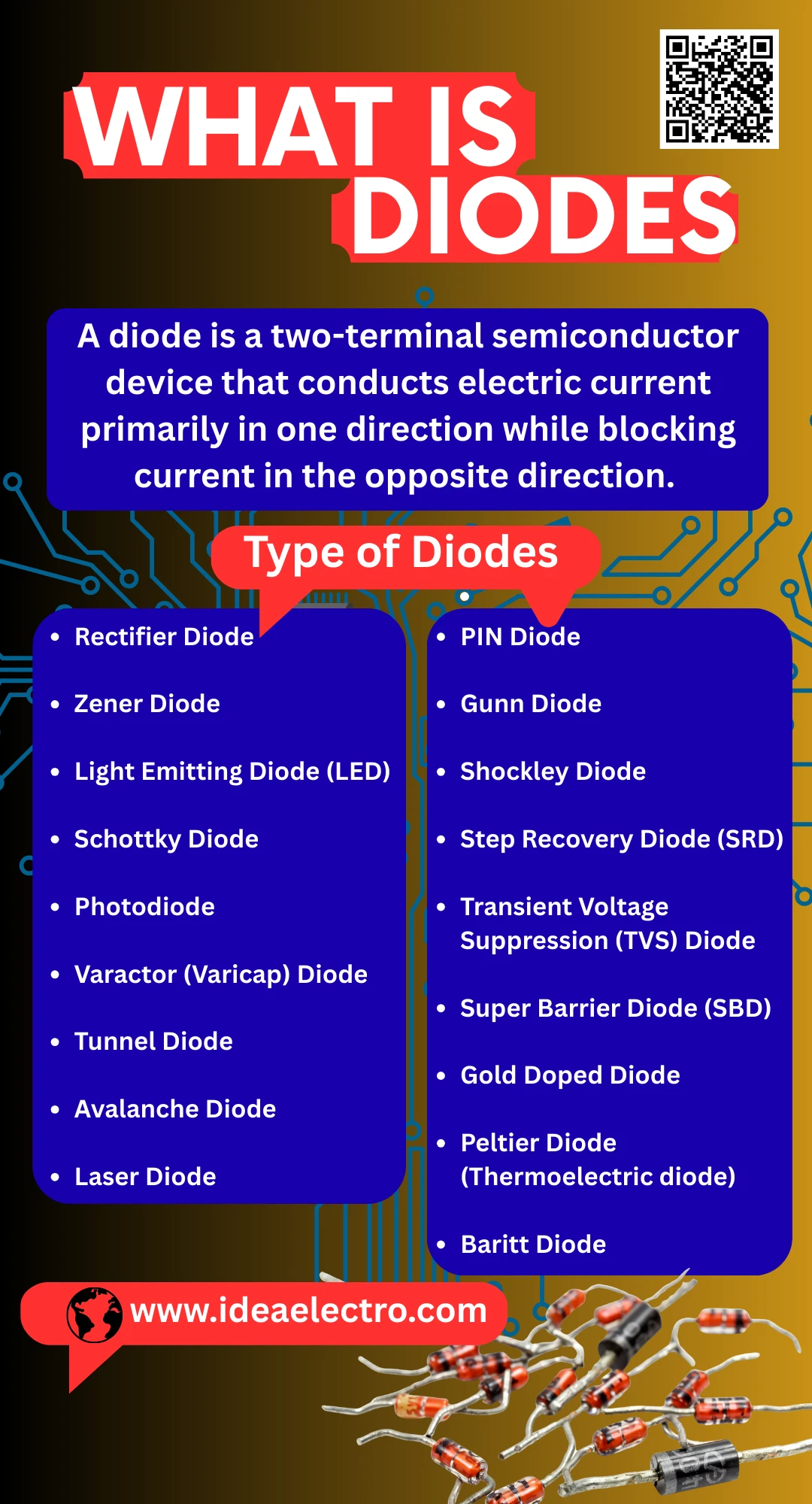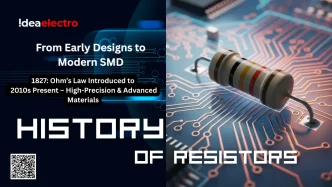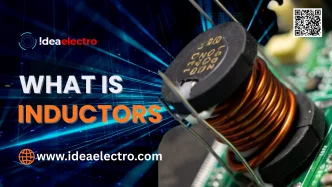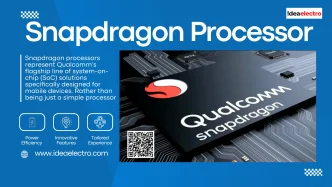Diodes represent one of the most fundamental components in modern electronics, serving as the electronic equivalent of a one-way valve for electrical current. These small but crucial semiconductor devices are indispensable in countless electronic circuits, from simple power supplies to sophisticated communication systems. Their ability to control current direction makes them essential for tasks ranging from power conversion to signal processing and circuit protection. Without diodes, many of the electronic devices we rely on daily would simply not function, as they provide critical functionality that enables the precise control and manipulation of electrical signals and power.
The importance of diodes in electronics cannot be overstated. They form the building blocks for more complex semiconductor devices and serve vital roles in virtually every electronic system. Consider these common examples of diodes in everyday devices:
- Power adaptersfor laptops and phones use diodes to convert AC wall power to DC power
- LED lightingin homes, vehicles, and displays relies on light-emitting diodes
- Radio receiversemploy diodes to extract audio signals from radio waves
- Voltage regulatorsuse special diodes to maintain stable operating voltages
- Circuit protectionsystems utilize diodes to prevent damage from voltage spikes
These diverse applications demonstrate why understanding diodes is essential for anyone interested in electronics, electrical engineering, or circuit design. From their initial discovery in the early 20th century to their current ubiquitous presence in electronic devices, diodes have consistently proven to be among the most versatile and necessary components in electrical engineering.
Definition: What Exactly Is a Diode?
A diode is a two-terminal semiconductor device that conducts electric current primarily in one direction while blocking current in the opposite direction. This unidirectional current flow property, known as rectification, forms the basis for countless electronic applications. Diodes are constructed by joining a p-type semiconductor material, which has an abundance of positive charge carriers (holes), with an n-type semiconductor material, which has an abundance of negative charge carriers (electrons) . The resulting structure is called a p-n junction, which creates the fundamental one-way conduction characteristic that defines diode operation.
The semiconductor materials most commonly used in diode construction include silicon, germanium, and gallium arsenide, each offering different performance characteristics suitable for various applications. The key aspects of diode definition and operation include:
- Asymmetric conductance: Diodes exhibit low resistance to current flow in one direction (forward bias) and very high resistance in the opposite direction (reverse bias)
- Two-electrode structure: Every diode has an anode (positive terminal) connected to the p-type material and a cathode (negative terminal) connected to the n-type material
- Non-linear current-voltage relationship: Unlike resistors, diodes do not follow Ohm’s Law but instead have an exponential relationship between voltage and current
- Threshold operation: Diodes require a minimum forward voltage to begin conducting significantly, typically 0.7V for silicon diodes and 0.3V for germanium diodes
This deliberate creation of asymmetric conductivity through semiconductor engineering enables the diode’s valuable rectification capabilities, making it possible to convert alternating current to direct current, protect circuits from reverse polarity, and perform many other essential electronic functions. The simple yet sophisticated p-n junction structure makes the diode one of the most widely used semiconductor devices in existence today.
How a Diode Works (Simple Explanation)
The operation of a diode centers around the behavior of the p-n junction, which forms when p-type and n-type semiconductor materials are joined together. At this junction, electrons from the n-type region diffuse into the p-type region, while holes from the p-type region diffuse into the n-type region. This exchange creates a narrow zone on either side of the junction called the depletion region, which becomes depleted of mobile charge carriers and thus acts as a barrier to current flow. The depletion region establishes a potential barrier that must be overcome for significant current to flow through the diode, much like a hill that electrons must climb over.
The behavior of this p-n junction changes dramatically depending on how external voltage is applied, leading to two fundamental operating states:
- Forward Bias: When a positive voltage is applied to the anode (p-type) relative to the cathode (n-type), the external voltage counteracts the internal potential barrier. This causes the depletion region to become narrower, reducing its resistance. When the applied voltage exceeds the diode’s threshold voltage(approximately 0.7V for silicon diodes), the potential barrier is effectively eliminated, allowing significant current to flow freely through the diode from anode to cathode
- Reverse Bias: When a negative voltage is applied to the anode relative to the cathode, the external voltage reinforces the internal potential barrier. This causes the depletion region to widen, increasing its resistance dramatically. In this state, only a very small leakage current(typically microamperes or less) flows through the diode, effectively blocking current flow
The following text-based diagram illustrates the p-n junction under different bias conditions:
text
FORWARD BIAS: (Current Flows)
P-type | N-type
(+) —-> |—–> (-)
Depletion Region: Narrow
Current: High
REVERSE BIAS: (Minimal Current)
P-type | N-type
(-) <—- |<—– (+)
Depletion Region: Wide
Current: Very Low (Leakage)
This asymmetric response to voltage polarity—allowing easy current flow in one direction while strongly resisting it in the opposite direction—is the fundamental property that makes diodes so useful in electronic circuits. The diode essentially functions as an electronic check valve, enforcing unidirectional current flow in circuits regardless of how the surrounding voltages might fluctuate.
Types of Diodes and Their Uses
While all diodes share the basic property of unilateral conduction, various specialized types have been developed with unique characteristics tailored to specific applications. Engineers can select from a diverse family of diode technologies, each optimized for different operating conditions and performance requirements. This specialization enables diodes to perform functions far beyond simple rectification, including voltage regulation, light emission, light detection, and high-frequency operation.
The table below presents several common diode types and their distinctive characteristics:
| Diode Type | Function | Common Applications |
| Rectifier Diode | Converts AC to DC | Power supplies, battery chargers, rectification circuits |
| Zener Diode | Voltage regulation | Voltage regulators, surge protectors, reference voltage circuits |
| Light Emitting Diode (LED) | Emits light when forward biased | Indicator lights, displays, lighting |
| Schottky Diode | Low forward voltage drop, fast switching | Power rectifiers, RF circuits, high-speed switching |
| Photodiode | Converts light into current | Light sensors, solar cells, optical communication |
| Varactor (Varicap) Diode | Variable capacitance with applied voltage | Voltage-controlled oscillators, RF tuning circuits |
| Tunnel Diode | Negative resistance, fast switching | High-frequency oscillators, microwave circuits |
| Avalanche Diode | Operates in reverse breakdown for voltage protection | Surge protection, high-voltage circuits |
| Laser Diode | Emits coherent light | Optical communication, laser pointers, barcode scanners |
| PIN Diode | Acts as variable resistor at RF, high-frequency | RF switches, attenuators, photodetectors |
| Gunn Diode | Microwave frequency generation | Microwave oscillators, radar transmitters |
| Shockley Diode | Four-layer diode for switching | Trigger circuits, switching applications |
| Step Recovery Diode (SRD) | Sharp pulse generation | High-speed switching, pulse generation in RF circuits |
| Transient Voltage Suppression (TVS) Diode | Protects circuits from voltage spikes | Surge protectors, ESD protection |
| Super Barrier Diode (SBD) | Combines low forward drop with high-speed switching | Power rectifiers, efficient switching converters |
| Gold Doped Diode | Fast recovery diode with gold impurities | High-speed rectifiers, pulse circuits |
| Peltier Diode (Thermoelectric diode) | Generates voltage from temperature difference | Thermoelectric sensors, energy harvesting |
| Baritt Diode | Microwave signal generation | Radar systems, microwave oscillators |
Rectifier diode represent the most common type, designed specifically for power supply applications where they convert alternating current to direct current. These diodes are characterized by their ability to handle relatively high current levels and withstand substantial reverse voltages without breaking down.
Zener diode by contrast, are intentionally designed to operate in the reverse breakdown region, where they maintain a nearly constant voltage despite variations in current, making them ideal for voltage regulation tasks.The specialization continues with
light-emitting diode (LEDs), which convert electrical energy directly into light through electroluminescence and have revolutionized lighting and display technologies.
Schottky diode employ a metal-semiconductor junction rather than a p-n junction, resulting in faster switching speeds and lower forward voltage drops than conventional rectifier diodes.
Photodiode operate in reverse bias and are designed to detect light, generating a current proportional to light intensity, while
varactor diode exploits the voltage-dependent capacitance of reverse-biased p-n junctions for electronic tuning applications. This diversity of specialized diode types ensures that engineers have precisely the right component for virtually any application requirement.
Tunnel diode is a unique semiconductor device renowned for its negative resistance characteristic. This property arises from quantum mechanical tunneling, where electrons directly pass through a potential barrier. This allows the diode to operate at extremely high frequencies, in the microwave range. Unlike conventional diodes, its current decreases over a specific voltage range as voltage increases. This makes it invaluable for specialized applications, including high-speed oscillators, amplifiers, and switching circuits. Despite being largely superseded by newer technologies, its ultra-fast operation ensures it remains relevant in niche, high-frequency electronics and low-noise microwave applications.
Avalanche diode is a semiconductor device designed to operate in the reverse breakdown region, where it experiences avalanche multiplication. This controlled breakdown allows it to handle high power levels, making it ideal for applications such as voltage regulation, microwave RF generation, and surge protection. Its rugged nature is key for protecting circuits from voltage transients.
Laser diode is a semiconductor device that generates coherent, monochromatic light through the process of stimulated emission. When electrically energized, electrons recombine with electron holes within the device, releasing photons. This light is then amplified between mirrored ends to create a precise, focused beam. These efficient, compact lasers are fundamental to modern technology, enabling fiber optic communications, barcode scanners, laser printers, and optical disc drives like Blu-ray.
PIN diode is a semiconductor device featuring a large, undoped intrinsic (I) region sandwiched between P-type and N-type regions. This wide intrinsic area gives it unique properties: when forward-biased, it acts as a variable resistor at radio frequencies, and when reverse-biased, it functions as an excellent capacitor. These traits make it ideal for RF switches, attenuators, and photodetectors, where its high-speed switching and linearity are crucial.
Gunn diode is a unique semiconductor component that operates on the Gunn effect, transferring electrons between high and low mobility states to generate microwave oscillations. This phenomenon produces a negative resistance region, enabling the diode to function without a traditional PN junction. Primarily fabricated from gallium arsenide, it is extensively used as a low-power, high-frequency oscillator in radar systems, microwave relays, and alarm sensors.
Shockley diode is a four-layer (PNPN) semiconductor device that acts as a trigger switch. Unlike a standard diode, it remains off until the voltage across it exceeds a specific breakover threshold, causing it to latch on and conduct heavily. Once triggered, it remains on until the current drops below its holding level. This bistable behavior was foundational for early thyristor and silicon-controlled rectifier (SCR) development.
Step Recovery Diode (SRD) is a semiconductor device engineered for an extremely fast turn-off characteristic. It operates by storing charge in its intrinsic region when forward-biased. Upon switching to reverse bias, it conducts briefly before abruptly ceasing current flow. This sharp transition, generating rich harmonic content, makes the SRD exceptionally valuable for building frequency multipliers and high-speed pulse generators in microwave and RF circuits.
Transient Voltage Suppression (TVS) Diode is a specialized semiconductor designed to protect sensitive electronics from voltage spikes and transients, such as electrostatic discharge (ESD) and power surges. It operates by shunting excess current when the voltage exceeds its breakdown level, reacting in picoseconds. This rapid clamping action safely diverts harmful energy away from protected circuits, making it vital for safeguarding data lines, power supplies, and communication ports.
Super Barrier Diode (SBD) is an advanced rectifier that combines the best features of Schottky and PN junction diodes. It utilizes a MOS structure to create a low forward voltage drop, similar to a Schottky, but with superior performance. Key advantages include very low reverse leakage current and high reliability, making it ideal for high-efficiency power supplies, DC-DC converters, and preventing reverse polarity.
Gold Doped Diode is a specialized semiconductor where gold is deliberately diffused into the silicon crystal structure. The gold atoms act as recombination centers, drastically reducing the lifetime of minority charge carriers. This results in an exceptionally fast switching speed, making these diodes valuable in high-speed computer and switching circuits of the past. However, this speed comes at the cost of a higher forward voltage and increased leakage current.
Peltier Diode is a misnomer, as the Peltier effect describes thermoelectric heat transfer, not rectification. A thermoelectric device, or Peltier cooler, uses electrical current to pump heat from one side to the other, creating a temperature differential. This solid-state mechanism allows for precise cooling or heating without moving parts and is reversible, also enabling power generation from waste heat in some applications.
Baritt Diode (Barrier Injection Transit-Time) is a microwave semiconductor device that operates on the thermionic emission of carriers, typically holes, across a forward-biased junction into a drift region. This transit-time delay creates a negative resistance effect, enabling microwave oscillation. While offering lower noise than IMPATT diodes, it provides lower power output, making it suitable for local oscillators in radar detectors and low-noise microwave receivers.
 Key Characteristics and Parameters of a Diode
Key Characteristics and Parameters of a Diode
To effectively select and implement diodes in electronic circuits, engineers must understand their key operational parameters and performance characteristics. These specifications quantify how a diode will behave under various operating conditions and provide the necessary data for proper circuit design. The most critical parameters define the diode’s voltage requirements, current handling capabilities, switching speed, and leakage behavior, collectively describing the device’s operational limits and performance envelope.
The essential characteristics and parameters of diodes include:
- Forward Voltage Drop (Vf): The voltage across the diode when conducting in the forward direction, typically 0.7V for silicon diodes and 0.3V for germanium diodes. This value represents the minimum voltage “lost” across the diode when it’s conducting and directly impacts power efficiency in rectifier circuits
- Reverse Breakdown Voltage (Vbr): The maximum reverse voltage a diode can withstand before it begins conducting significantly in the reverse direction. Exceeding this voltage may cause permanent damage to standard diodes but is the normal operating region for Zener diodes
- Maximum Forward Current (If): The highest continuous forward current the diode can safely handle without overheating or being damaged. This rating is particularly important in power supply applications where diodes may be subjected to heavy loads
- Reverse Recovery Time (trr): The time required for a diode to switch from the conducting state to the non-conducting state when the voltage polarity reverses. This parameter determines the maximum switching speed and is crucial in high-frequency applications
- Reverse Leakage Current (Ir): The small current that flows through a diode when it is reverse-biased. Ideally, this should be zero, but in practical diodes, a tiny leakage current exists due to minority carrier movement
These parameters interact to define a diode’s suitability for specific applications. For instance, power supply rectifiers require diodes with high forward current ratings and high reverse breakdown voltages, while radio frequency circuits need diodes with fast reverse recovery times. The forward voltage drop directly affects circuit efficiency, as power dissipated in the diode equals the forward current multiplied by the forward voltage drop. Similarly, the reverse leakage current becomes critically important in high-impedance circuits or applications where very low standby power consumption is required. Understanding these interrelationships allows engineers to make informed decisions when selecting diodes for specific design requirements.
Practical Applications of Diodes in Everyday Electronics
The unique properties of diodes make them indispensable components in virtually every electronic system we encounter in daily life. Their ability to control current direction, regulate voltage, emit light, and protect sensitive circuitry enables functionalities that modern technology depends on. From power conversion to signal processing and circuit protection, diodes perform critical roles across diverse applications, often working behind the scenes to ensure proper operation of electronic devices.
One of the most significant applications of diodes is in power supply rectification. Diodes form the heart of rectifier circuits that convert alternating current from wall outlets to the direct current required by electronic devices. In half-wave rectifiers, a single diode removes either the positive or negative portions of an AC waveform, while in full-wave rectifiers, multiple diodes (typically arranged in a bridge configuration) convert both halves of the AC cycle to produce a smoother DC output. This rectification process represents the essential first step in AC-to-DC power conversion for everything from smartphone chargers to computer power supplies.
Beyond power conversion, diodes serve numerous other critical functions:
- Signal Demodulation: Diodes extract audio and other information from amplitude-modulated radio signals in receivers, enabling radio communication and broadcasting
- Voltage Regulation: Zener diodes maintain a constant voltage across loads in power supplies despite variations in input voltage or load current, providing stable operating voltages for sensitive electronic components
- ESD and Voltage Spike Protection: Specialized diodes shunt harmful electrostatic discharges and voltage transients away from sensitive integrated circuits, preventing damage to expensive electronic components
- Light Emission: Light-emitting diodes provide efficient, long-lasting illumination for lighting applications, electronic indicators, displays, and optical communications
A specific example of diode application can be found in automotive systems, where diodes prevent battery discharge through parallel circuits when the engine is off, protect sensitive electronic control units from voltage spikes generated by inductive loads, and form the alternator’s rectifier assembly that charges the battery while the engine runs. Similarly, in solar power systems, blocking diodes prevent batteries from discharging back through solar panels at night, while bypass diodes allow current to flow around shaded or damaged solar cells to maintain system operation. These diverse implementations demonstrate how diodes solve fundamental electrical challenges across nearly all fields of electronics.
Advantages and Limitations of Diodes
Like all electronic components, diodes offer specific advantages that make them valuable for circuit design, while also presenting certain limitations that engineers must consider during the design process. Understanding these strengths and weaknesses is essential for effectively implementing diodes in electronic systems and for recognizing situations where alternative components might be more appropriate. The practical utility of diodes stems from how well their advantages align with common circuit requirements, while design challenges often arise from their inherent limitations.
The following table contrasts the primary advantages and limitations of diodes:
| Advantages | Limitations |
| Simple construction and low cost for basic types | Fixed voltage drop causes power loss and heating |
| High reliability and long operational lifetime | Non-ideal reverse characteristics allow some leakage current |
| Fast response times enable high-frequency operation | Limited maximum operating temperature due to semiconductor properties |
| Small physical size facilitates circuit miniaturization | Vulnerability to voltage and current surges without proper protection |
| Unidirectional current control without moving parts | Performance variations with temperature requiring compensation in precision circuits |
Diodes provide numerous benefits that explain their widespread adoption in electronic circuits. Their solid-state construction without moving parts makes them exceptionally reliable with virtually unlimited lifespan under proper operating conditions. The manufacturing processes for standard diodes are well-established, resulting in low production costs that make them economical even in consumer-grade electronics. Perhaps most importantly, diodes perform their core function of unidirectional current control with excellent precision and repeatability, while specialized variants extend this functionality to include light emission, voltage regulation, and capacitance control.
Despite these advantages, diodes also present significant limitations that circuit designers must address. The inherent forward voltage drop, while useful for voltage reference applications, represents power loss that reduces system efficiency and generates heat that must be managed. The reverse leakage current, though small, can be problematic in high-impedance circuits or applications requiring extremely low power consumption. Semiconductor diodes have maximum operating temperature limits beyond which they may suffer permanent damage, and their electrical characteristics typically vary with temperature, necessitating compensation techniques in precision applications. Additionally, diodes are susceptible to damage from voltage transients and current surges, often requiring additional protection components in harsh electrical environments. Despite these limitations, diodes remain among the most useful components in electronics, particularly when their specific characteristics are properly matched to application requirements.
Basic Circuit Example: How a Diode Is Used
To illustrate the practical implementation of diode principles, consider a simple half-wave rectifier circuit, which represents one of the most fundamental and common applications of diodes. This circuit converts alternating current to pulsating direct current using just a single diode, demonstrating how effectively diodes can control current direction to achieve useful functions. The half-wave rectifier forms the foundation of many power supply designs and clearly exhibits the core rectification property that makes diodes so valuable in electronic systems.
Constructing and analyzing this basic circuit involves the following steps:
- Circuit Components: The circuit requires an AC voltage source (such as a transformer secondary), a single diode, and a load resistor through which the rectified current flows. The diode is represented in schematics by a triangle pointing toward a vertical bar, with the triangle indicating the anode and the bar representing the cathode
- Positive Half-Cycle Operation: During the positive half-cycle of the AC input voltage, the diode becomes forward-biasedwhen the anode voltage exceeds the cathode voltage by at least the diode’s forward voltage threshold (approximately 0.7V for silicon diodes). In this state, current flows freely through the diode and the load resistor, creating an output voltage across the load that closely follows the positive portion of the input AC waveform
- Negative Half-Cycle Operation: During the negative half-cycle of the AC input, the diode becomes reverse-biased, with the cathode voltage exceeding the anode voltage. In this state, the diode blocks current flow, preventing the negative portion of the AC waveform from reaching the load resistor. The output voltage during this period remains essentially zero, with only a tiny leakage current potentially flowing
- Output Waveform: The resulting output across the load resistor consists of a series of positive half-cycles separated by gaps during the negative half-cycles, creating a pulsating DC voltage rather than the pure DC produced by batteries. This pulsating DC can be smoothed using capacitors and filters to create a more stable DC voltage suitable for powering electronic devices
This simple yet effective circuit demonstrates the diode’s fundamental property of unidirectional conduction in the most straightforward manner possible. While practical power supplies typically use more sophisticated full-wave rectifier configurations that utilize both halves of the AC input cycle, the half-wave rectifier clearly illustrates the core principle of rectification. The circuit also highlights important practical considerations, such as the inevitable forward voltage drop across the diode and the need for the input voltage to exceed this threshold before conduction begins. Understanding this basic circuit provides a solid foundation for comprehending more complex diode applications and their implementations in practical electronic devices.
Frequently Asked Questions About Diodes
Both beginners and experienced electronics enthusiasts often have questions about diode properties, implementation, and troubleshooting. Addressing these common inquiries provides valuable insight into practical considerations when working with diodes in circuit design and prototyping. The following questions and answers cover some of the most fundamental aspects of diode usage that frequently arise in educational and professional contexts.
- How can I identify diode polarity?Most diodes have a visible marking to indicate the cathode terminal. Through-hole diodes typically have a stripe or band painted near the cathode lead, while surface-mount devices may use a line, dot, or tapered end to mark the cathode. Additionally, the cathode lead is often shorter than the anode lead in LEDs. When in doubt, consult the manufacturer’s datasheet or use a multimeter’s diode test function to determine polarity
- How do I test a diode using a multimeter?Set a digital multimeter to its diode test function (usually indicated by a diode symbol). Connect the red probe to one terminal and the black probe to the other. If the display shows a voltage reading between 0.6-0.7V for silicon diodes (or 0.25-0.3V for germanium), the red probe is touching the anode and the black probe the cathode. If the display shows “OL” or overload, reverse the probes. A good diode should show a reasonable forward voltage in one direction and “OL” in the reverse direction
- Why do LEDs require current-limiting resistors?Unlike standard diodes, LEDs have a very low internal resistance once their forward voltage is exceeded, causing them to draw excessive current that can quickly destroy the device. A series resistor limits current to a safe value, ensuring proper operation and preventing thermal damage. The required resistor value can be calculated using Ohm’s Law based on the supply voltage, LED forward voltage, and desired operating current
- What happens if I connect a diode backward in a circuit?In most applications, a reverse-connected diode will block current flow when it should conduct and may prevent the circuit from functioning altogether. In power supply circuits, a backward diode may block all current flow, while in protection circuits it might inadvertently conduct and potentially cause short circuits. In some cases, reverse connection can permanently damage the diode or other circuit components, particularly if reverse voltage ratings are exceeded
- Can a diode work both ways?Standard p-n junction diodes are fundamentally unilateral devices that conduct only in one direction. However, some specialized components like Zener diodes are designed to conduct in reverse bias once a specific breakdown voltage is reached, while others like alternating current switches (DIACs) are specifically engineered for bidirectional operation. For conventional rectifier and signal diodes, however, current flow remains strictly unilateral
Conclusion
Diodes stand as one of the most fundamental and versatile components in modern electronics, providing essential functionality that enables the operation of countless electronic devices and systems. From their simple yet ingenious p-n junction structure to their diverse specialized forms, diodes solve critical circuit challenges including power rectification, voltage regulation, signal demodulation, and circuit protection. Their ability to enforce unidirectional current flow makes them indispensable for converting AC to DC, while specialized variants extend this functionality to include light emission, voltage reference generation, and numerous other applications.
The continuing evolution of diode technology has yielded increasingly sophisticated devices with enhanced performance characteristics, ensuring that diodes remain relevant even as electronic systems become more complex and integrated. From the early crystal detectors of radio receivers to modern high-efficiency LEDs and ultrafast switching diodes, these components have consistently adapted to meet the demands of advancing electronic technologies. Their simple concept—controlling current direction through semiconductor physics—belies their profound importance in enabling the sophisticated electronic systems that define modern life. As electronics continue to evolve toward higher frequencies, lower power consumption, and greater integration, the fundamental principles of diode operation will undoubtedly continue to inform and enable new generations of electronic devices and applications.









